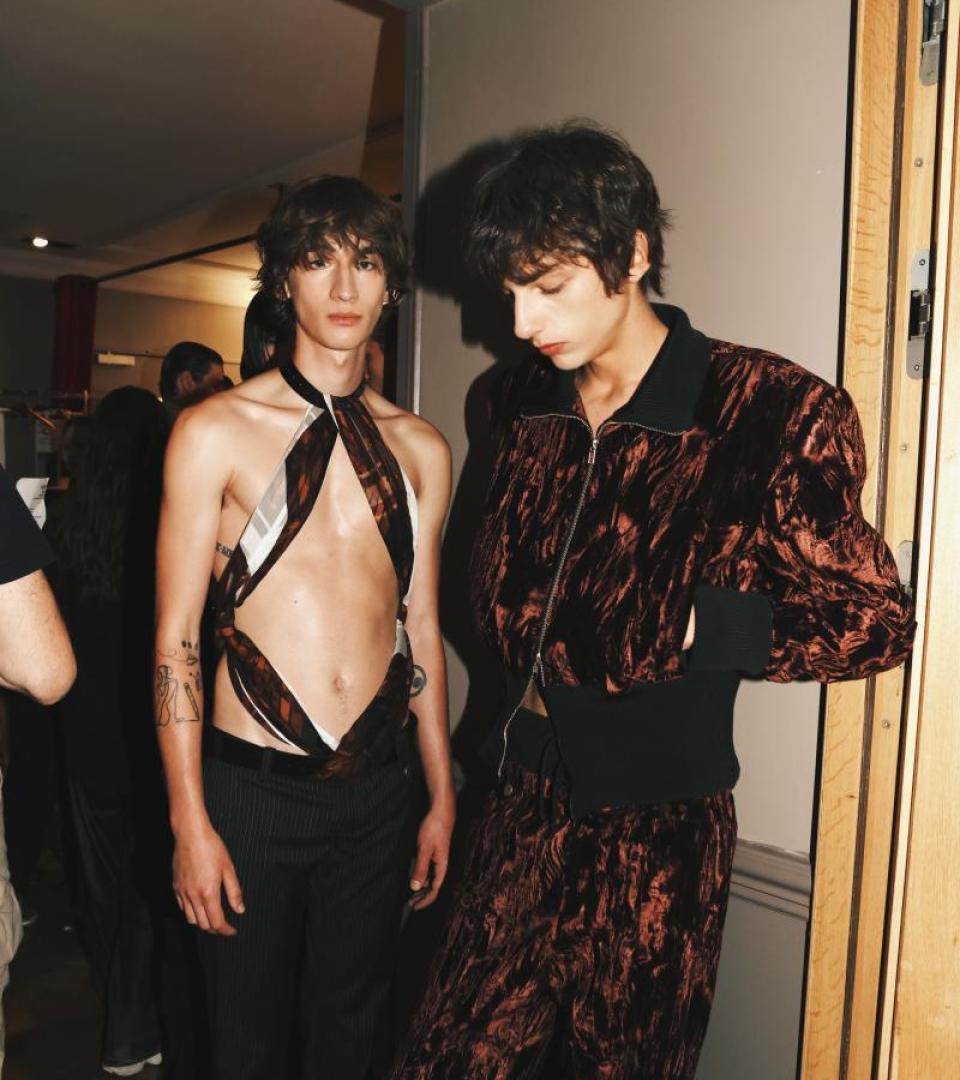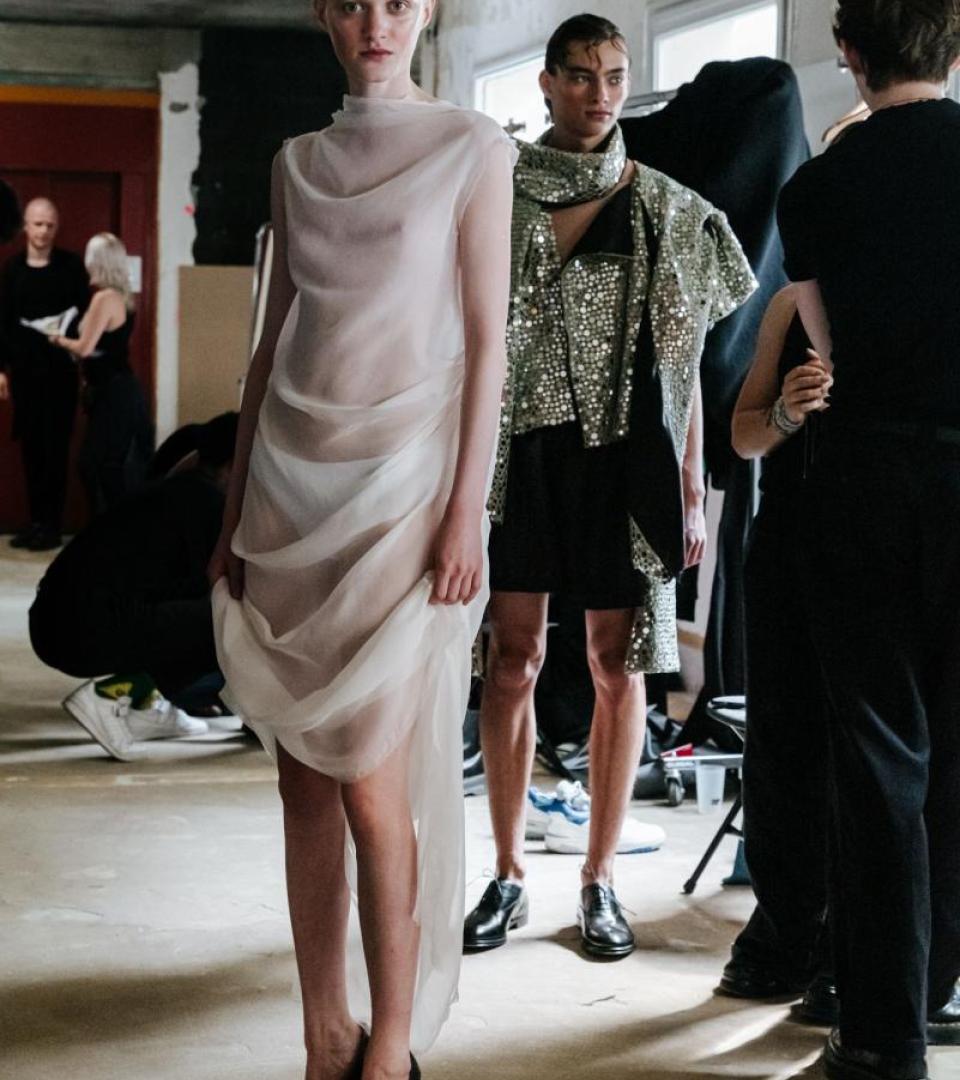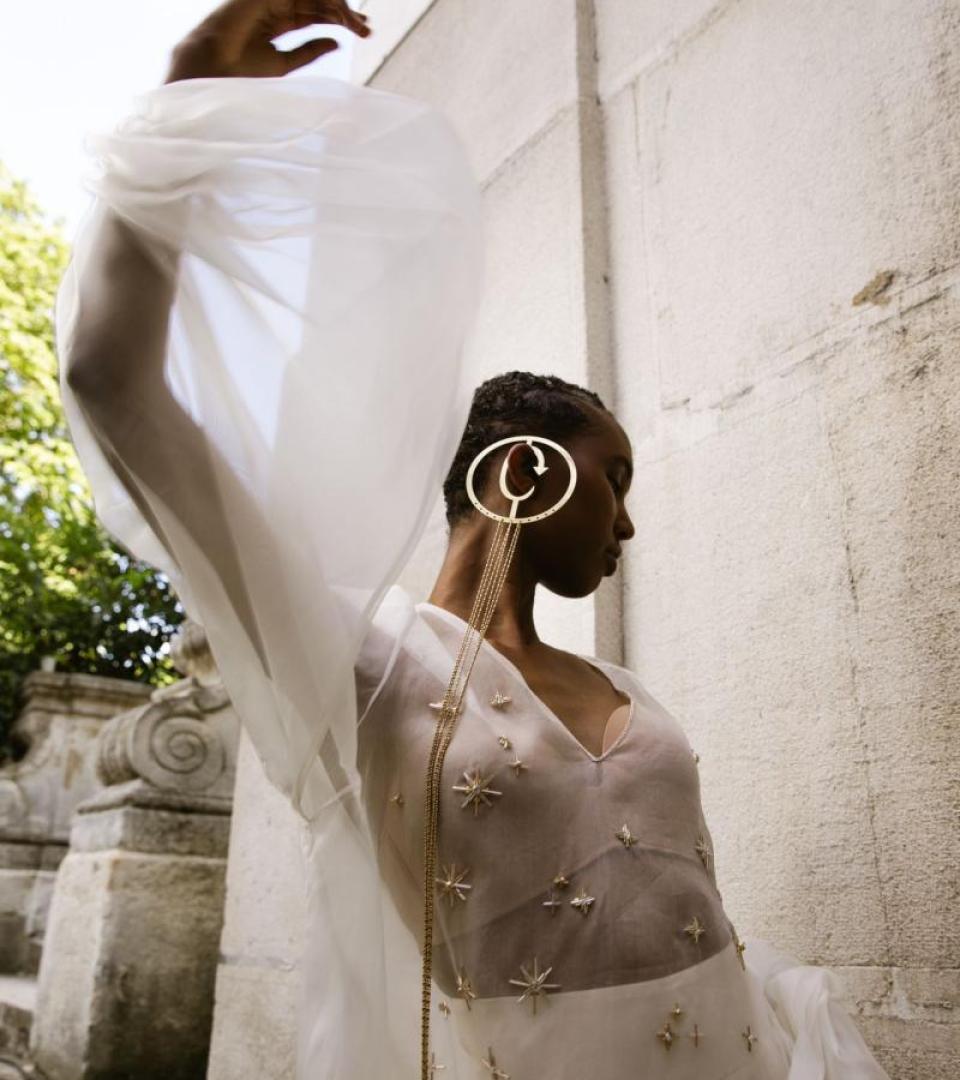Jean-Jacques Picart: "Fashion is but the expression of the spirit of the times."
Capturing the spirit of the times, the zeitgeist, isn't an intellectual pursuit. It's about instinct, the irrational, that requires the ability to let oneself be carried, antennae up, by the currents that flow through an era and shape it. Jean-Jacques Picart, publicist turned consultant if one must classify him, exudes a creative flair and a sensitivity that captures the essence of the current moment without conscious effort, led by what he calls his "taste for people."
"At 10 years old, when people asked me what I wanted to become, I always answered ‘doctor, obstetrician, pediatrician.’"A startling answer, in part because it contains three professions in one, but also because it crystallises the entire career of a man who "likes to make people give birth to themselves." In keeping with the Socratic tradition of maieutics, which consisted of asking people a series of questions to enable them to reveal themselves, Picart "feels the hidden side of people."
Born in Phnom-Penh, Picart left what was then Indochina at the age of 11 for Nice, where he grew up with his Vietnamese maternal grandmother. His "Asian legacy" left a deep mark on his "intellectual and emotional approach." When he joined his mother in Dakar to graduate from high school, he was 17 and had no idea of what he wanted to become. "I was good at philosophy but very bad at science, so I wouldn't be a doctor," he admits with a smile. In Dakar's Médina district, he consulted a professional orientation centre. "They probably thought I wasn't too stupid and sensitive and advised me to opt for decorating or press relations," a profession that was still in its infancy. "You'll be able to sell anything," they told him; "which is true." he adds quietly.
Freshly arrived in Paris in 1966, he joined a press relations school. On the school benches, he stomped his feet. "I was interested in the job, but people chatted too much for me to follow the classes," he recalls. He didn't feel at his place there, the migratory bird having laid its claws among "the young girls from the 16th arrondissement." After six months of turning in his cage, he asked the management to validate his diploma through professional experiences. "I besieged the office of the internship director," he says. Stubborn and determined, he completed "eleven internships in two years, a record at the time! " From little strokes came a great network.
"I never really intended to venture into fashion."
What interests him most is people, to meet them and make them blossom. After working as an assistant until 1972, Picart set up his own press office, encouraged by his first contacts. His first client was Guy Paulin, "a wonderful couturier that people have forgotten," who worked for Dorothée Bis and then Chloé from 1984 to 1986. A designer with a casual style, tender and unpretentious, like the soft colours he used. "In fashion, when you're ahead, it's as if you're behind. People don't buy and then forget that you were the first to do it," Picart asserts. "It was Guy Paulin who introduced me to Thierry Mugler in 1975." Mugler had just returned from New York "where he was with Claude Montana. They were selling papier-mâché jewellery for a living, both completely unknown at the time."
"I need a publicist," Mugler insisted over the phone. Before hanging up, Picart asked him, "How will I recognise you?" far from suspecting that Mugler would "turn up at La Coupole dressed as D'Artagnan." "I couldn't understand a word he was saying. He was in his own world, in such a bubble," recalls Picart, who ended up telling him that they couldn't work together, simply because he didn't understand a word. "That's why it’s good. People tell me you do your job well and I'll do mine well." Mugler concluded. Their collaboration lasted several years, advancing Mugler towards the pantheon of global fashion as a craftsman of the spectacular. Picart remembers Mugler above all as a "creative logorrhoea," an artist who "planned an unrealistic number of pieces for a season, a whirlwind of ideas, and a man who was very respectful of others, a rare quality in our profession."
Thierry Mugler, bolstered by Picart, presented his first collections alongside Claude Montana and Anne-Marie Berreta in a shared tent, for lack of funds, in front of the Palais des Congrès. "We weren't in the Official Calendar and journalists complained that we were presenting on Sundays," recalls Picart. At the time, ready-to-wear design was still an embryo, propelled by the creation of Saint Laurent Rive Gauche in 1966. Fashion was gradually becoming institutionalised, with the creation of the Chambre Syndicale du Prêt-à-Porter des Couturiers et des Créateurs de Mode (which later became the Chambre Syndicale de la Mode Féminine) and the Chambre Syndicale de la Mode Masculine in 1973. Fashion Week took shape.
"Integrity remains the key to our profession."
"Backstage, I'd say ‘have you seen your look? Are you sure? In 40 seconds, what you've done will belong to the others.’ I wanted them to be able to fully take on the criticism and the applause." Picart sees sincerity as a mark of respect. "I've always told my clients the truth. Designers are afraid of dishonest criticism. It's very unpleasant for them not to be sure that their work is being sincerely reviewed."
From the outset and throughout his career, Picart refused to work for a brand unless he was "authorised to join the studio and the company's strategic committee, to see if what comes out of the studio is consistent with the CEO's strategy." Cacharel, Emanuel Ungaro, Hermès, Jean-Charles de Castelbajac, Kenzo, Chloé, Daniel Hechter, La Redoute, New Man, Levi's, Helmut Lang, Ferragamo, Jil Sander, Jean Patou: Picart multiplied projects and meetings. "I didn't have a plan. When a brand appealed to me, I wanted to work on it. So much so that I was criticised, ‘You like everything!’" Picart understands designers because he himself works on instinct and understands managers because he remains grounded in reality. One foot in, one foot out, to fully assume his role as "a regulator, a harmoniser, like a cop at a crossroads," he quips.
"I've saturated the market."
In 1980, despite his outstanding success, he closed his press office. "Some brands told me they wanted to work with me, but I was already working for their competitor." Lucid, the man who had grown up in different parts of the world listened carefully to what the times were telling him and complied readily. He then went into consulting, "a stupid word, but as I couldn't say ‘sincere advice’, so I kept consulting."
The Hermès years began. Alongside Jean-Louis Dumas, who headed the House from 1978 to 2006, and Pascale Mussard, founder of petit h and President of Villa Noailles since 2015, they reshaped the House's strategy. "Pascale is wonderful. We worked together, she inside and I outside." One day, while Picart was with Dumas in his office – "In the days when CEOs worked above the boutique" – they were told that Jackie Kennedy had just arrived. "She told us that the same morning they had taken her breakfast while reading ELLE and that she had seen the ‘jeans and scarf’ campaign." If that doesn't sound revolutionary to you, you may realise that at the time, pairing a silk scarf with a pair of jeans was a fine way to thumb one's nose at classic conventions, and a marvelous entry for the House into modernity. "Dumas introduced me to her as one of the authors of the campaign," he recalls, straightening in his seat. Yet Picart, feisty and reluctant to settle in one place for too long, left Hermès in 1983.
"Christian Lacroix owes his success to his exceptional talent as an artist."
"I met Christian Lacroix via his girlfriend, Françoise, who worked for me. She showed me his drawings," tells Picart, with no emphasis on the fact that chance had placed on his path an artist who would go on to become one of the most prestigious names in Haute Couture. Chance? More like his irrepressible attraction to "people with above-average brains." Christian Lacroix began his career at Guy Paulin and Hermès before joining Patou in November 1981, under the guidance of Picart. The firm, which joined the LVMH stable in 2015, has nurtured some exceptional talents, including Marc Bohan from 1954 to 1958, Karl Lagerfeld from 1958 to 1963 and Jean-Paul Gaultier, who joined the studio in 1972 under Michel Goma, until 1974. Lacroix left Patou in 1987, a week after his last fashion show, marking the end of Haute Couture for the house. He was backed up by Jean-Jacques Picart in charge of the image, to pave his own way.
"Bernard Arnault is on a ladder. He has a panoramic, global view that we don't have."
Bernard Arnault, who became Chairman of LVMH in January 1989, had been Chairman and CEO of Financière Agache S.A and Christian Dior S.A. since 1984. Picart met him in 1986. "Bernard Arnault was looking for a stylist to place at Dior as Marc Bohan's right-hand man." Picart, who was working for Patou with Lacroix at the time, replied that "it's better to be first in a small House than second in a big one. " Together, they orchestrated the launch of the Christian Lacroix House within the LVMH group in 1987. "I was a partner. It was the only time in my life that I wasn't independent," says Picart, who remembers Arnault's question: "Our friend Christian gives us his talent. I'll take care of the financing. What about you?", to which Picart replied: "I give you my freedom." He remained there until 1993. In the years that followed, Picart continued to "advise Arnault" and flitted around houses, for different projects between "Kenzo, Louis Vuitton, Pucci" among others.
Picart also introduced us to Hedi Slimane. In 1989, Picart went to the presentation of a collection designed by José Lévy, which he found "much better than the previous ones." Lévy introduced him to a friend "who helped him with the styling, Hedi Slimane." Slimane collaborated with Picart from 1992 to 1995. In 1996, Pierre Bergé called Picart to tell him "that he was going to hire the boy." "I replied that I was overjoyed for him." When Slimane left Saint Laurent, Picart picked up the phone: "I called Arnault to tell him that Slimane was on the market." And he made his debut at Dior Homme in July 2000. He then returned to Saint Laurent from 2012 to 2016, before joining Celine in February 2018.
"Let me tell you about the elegance of Pierre Bergé's tiny forget-me-nots."
"I miss Pierre Bergé terribly. Much more than I thought I would," confesses Picart, who recalls "an official attitude and a less official one. A kindness tinged with cruelty." "Christian Lacroix told me that it moved him to see me impressed in front of Pierre Bergé," Picart recalls, lowering his voice.
One day, when Picart was back in Paris after being away for health reasons, he received two bouquets of flowers. "One was splendid, taking up the whole table, and the other about the size of a small glass of water, filled with forget-me-nots, with a long, handwritten note. The first was sent by Bernard Arnault, the second by Pierre Bergé." Picart invited Lacroix to his home and showed him the two bouquets. "We signed with the beautiful, great bouquet when we would have liked to sign with the forget-me-nots." "Pierre Bergé taught me that what's chic is to do less. When you want to invite someone to a restaurant, don't go to the most beautiful place, choose your second best." Pierre Bergé has dedicated his life to revealing the beautiful, with passion and commitment. He chaired the Arcat Sida association, then in 1994, with Line Renaud, created the Ensemble contre le SIDA association, which later became Sidaction. In 2008, it was from the hands of Pierre Bergé that Picart was awarded Chevalier des Arts et des Lettres.
From luxury giants to mass-market goods, Picart has taken a leaf out of Uniqlo's book. "I felt that one of their campaigns strayed from what they are all about. It's a product, and you have to make that clear." He steered them towards collaborations, "not with designers but with women." He forged links between the Japanese giant and Inès de la Fressange, whose collaboration lasted 10 years, from 2014 to 2024, and Carine Roitfeld, who signed two exclusive collections in 2016.
"One thing I'm most aware of is that fate has been very kind to me. I've had an improbable career given where I come from. I've tried to honor this privileged destiny. I didn't waste it."
"I was born in the soil, out of my mother's rice fields and my father's beet fields," says Picart, whose journey in fashion has always been driven by his love for the creativity of the geniuses he encountered along the way. In 2017, he retired "out of clarity and logic." "I remain in love with fashion, but today my antennas aren't as sharp," he smiles. Picart still closely follows the industry's developments. "I particularly enjoy the work of Anthony Vaccarello and Alexandre Mattiussi. Their success is based as much on the quality of the clothing as on their communication, on the image." Looking ahead, Picart foresees "an undeniable return to the concept of clothing. I sense we'll see more intimate, selective presentations, while never neglecting what the internet and Instagram demand. There needs to be a dual approach to communication, " he predicts, adding that "there's a world of difference between what fashion insiders perceive from the collections and what customers see. Ultimately, fashion is about the meeting of a hanger and a credit card."
Christian Lacroix, Thierry Mugler, Claude Montana, Hedi Slimane, Helmut Lang, Riccardo Tisci, Éric Bergère, Guillaume Henry: the list of prestigious names who have benefited from his phenomenal intuition goes on. With an extraordinary flair, a Vanité Flair in sum, a sharp sense of expression, and a keen eye that scrutinises with attention, Jean-Jacques Picart invented a profession by constantly reinventing himself. He balanced the imagination of creatives with the reality of strategists, always attuned to the spirit of the times.
Reuben Attia



